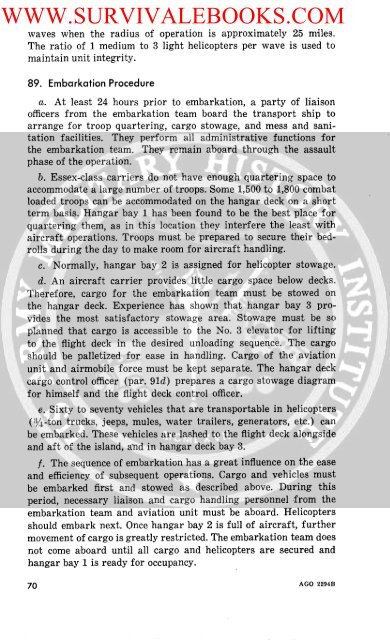FM 57-35 Airmobile Operations - Survival Books
FM 57-35 Airmobile Operations - Survival Books
FM 57-35 Airmobile Operations - Survival Books
- No tags were found...
Create successful ePaper yourself
Turn your PDF publications into a flip-book with our unique Google optimized e-Paper software.
WWW.SURVIVALEBOOKS.COMwaves when the radius of operation is approximately 25 miles.The ratio of 1 medium to 3 light helicopters per wave is used tomaintain unit integrity.89. Embarkation Procedurea. At least 24 hours prior to embarkation, a party of liaisonofficers from the embarkation team board the transport ship toarrange for troop quartering, cargo stowage, and mess and sanitation facilities. They perform all administrative functions forthe embarkation team. They remain aboard through the assaultphase of the operation.6. Essex-class carriers do not have enough quartering space toaccommodate a large number of troops. Some 1,500 to 1,800 combatloaded troops can be accommodated on the hangar deck on a shortterm basis. Hangar bay 1 has been found to be the best place forquartering them, as in this location they interfere the least withaircraft operations. Troops must be prepared to secure their bedrolls during the day to make room for aircraft handling.c. Normally, hangar bay 2 is assigned for helicopter stowage.d. An aircraft carrier provides little cargo space below decks.Therefore, cargo for the embarkation team must be stowed onthe hangar deck. Experience has shown that hangar bay 3 provides the most satisfactory stowage area. Stowage must be soplanned that cargo is accessible to the No. 3 elevator for liftingto the flight deck in the desired unloading sequence. The cargoshould be palletized for ease in handling. Cargo of the aviationunit and airmobile force must be kept separate. The hangar deckcargo control officer (par. 91d) prepares a cargo stowage diagramfor himself and the flight deck control officer.e. Sixty to seventy vehicles that are transportable in helicopters(%-ton trucks, jeeps, mules, water trailers, generators, etc.) canbe embarked. These vehicles are lashed to the flight deck alongsideand aft of the island, and in hangar deck bay 3./. The sequence of embarkation has a great influence on the easeand efficiency of subsequent operations. Cargo and vehicles mustbe embarked first and stowed as described above. During thisperiod, necessary liaison and cargo handling personnel from theembarkation team and aviation unit must be aboard. Helicoptersshould embark next. Once hangar bay 2 is full of aircraft, furthermovement of cargo is greatly restricted. The embarkation team doesnot come aboard until all cargo and helicopters are secured andhangar bay 1 is ready for occupancy.70 AGO 2294B
















